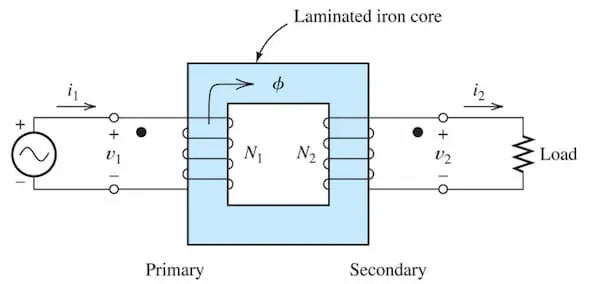
Always the dots in the primary and secondary coils will be opposing.
Copper loss
Section titled “Copper loss”The energy dissipated as heat in the windings of the transformer due to the resistance of the copper (or aluminum) conductors.
Here:
- - current flow
- - resistance of winding
Leakage flux
Section titled “Leakage flux”The portion of the magnetic flux generated by the transformer windings that does not link with the core or the other winding. This flux escapes into the surrounding air and does not contribute to energy transfer between the primary and secondary windings.
Ideal Transformer
Section titled “Ideal Transformer”- No copper losses in the winding
- No leakage flux
- Reluctance of the core () is 0
- No core losses
Equations
Section titled “Equations”As and are opposing:
As :
Impedance Transformation
Section titled “Impedance Transformation”Here:
- - impedance of the primary coil
- - impedance of the load in the secondary coil
The above transformation is used to convert a transformer into a single circuit for analysis.
Core losses
Section titled “Core losses”Eddy current
Section titled “Eddy current”Loops of electric current induced within conductors. Current flows in closed loop within a plane. Occurs because of a changing magnetic field in the conductor as described by Faraday’s law. Causes significant energy losses as heat.
To reduce eddy currents:
- Laminated cores: Use thin, insulated layers of magnetic material stacked together to restrict the flow of eddy currents.
- High-resistivity materials: Use materials with higher electrical resistance to reduce the magnitude of the currents.
Hysteresis
Section titled “Hysteresis”The lag between the changes in the magnetic flux density () and the magnetizing force () in a magnetic material. Occurs because the magnetic domains within the material do not align instantaneously with the applied magnetic field. As a result, when the magnetic field is cycled, the - curve forms a loop, known as the hysteresis loop.
The area of the hysteresis loop represents the energy lost as heat in the core material during each cycle of magnetization and demagnetization. This loss is known as hysteresis loss.
To reduce hysteresis losses:
- Use materials with narrow hysteresis loops, such as silicon steel or other soft magnetic materials.
- Optimize the operating frequency to minimize the energy dissipated in the core.